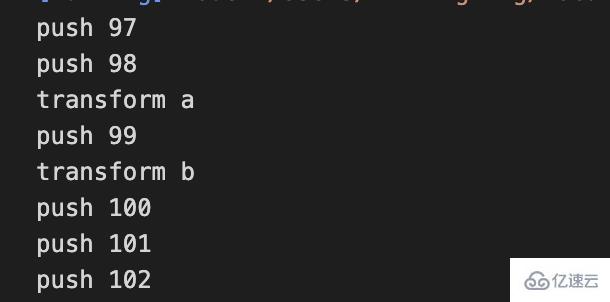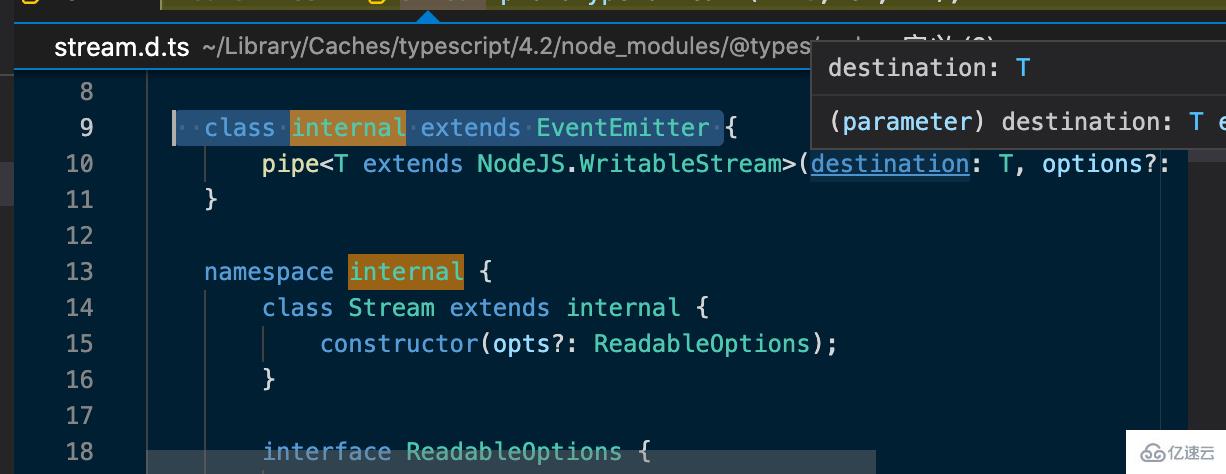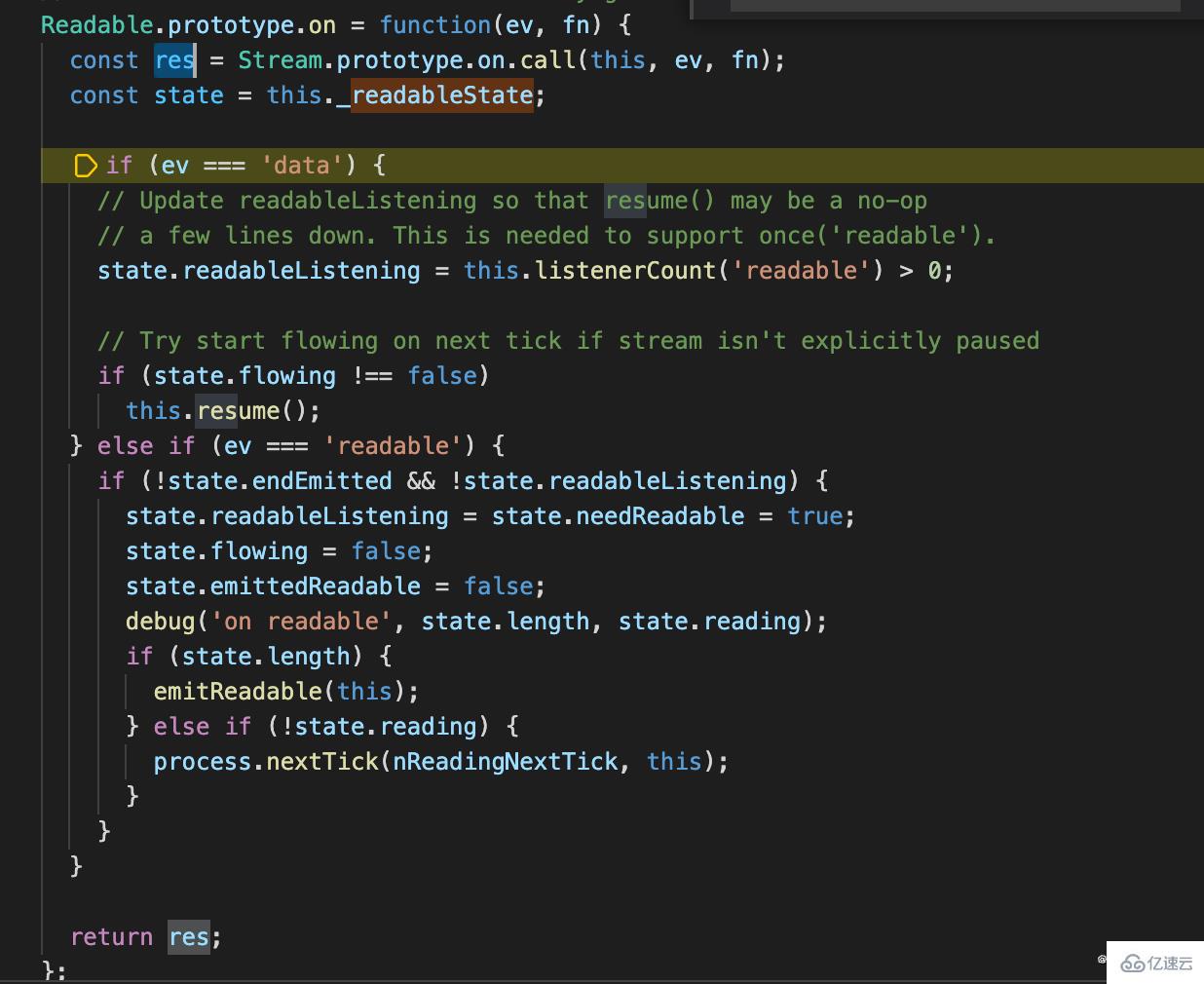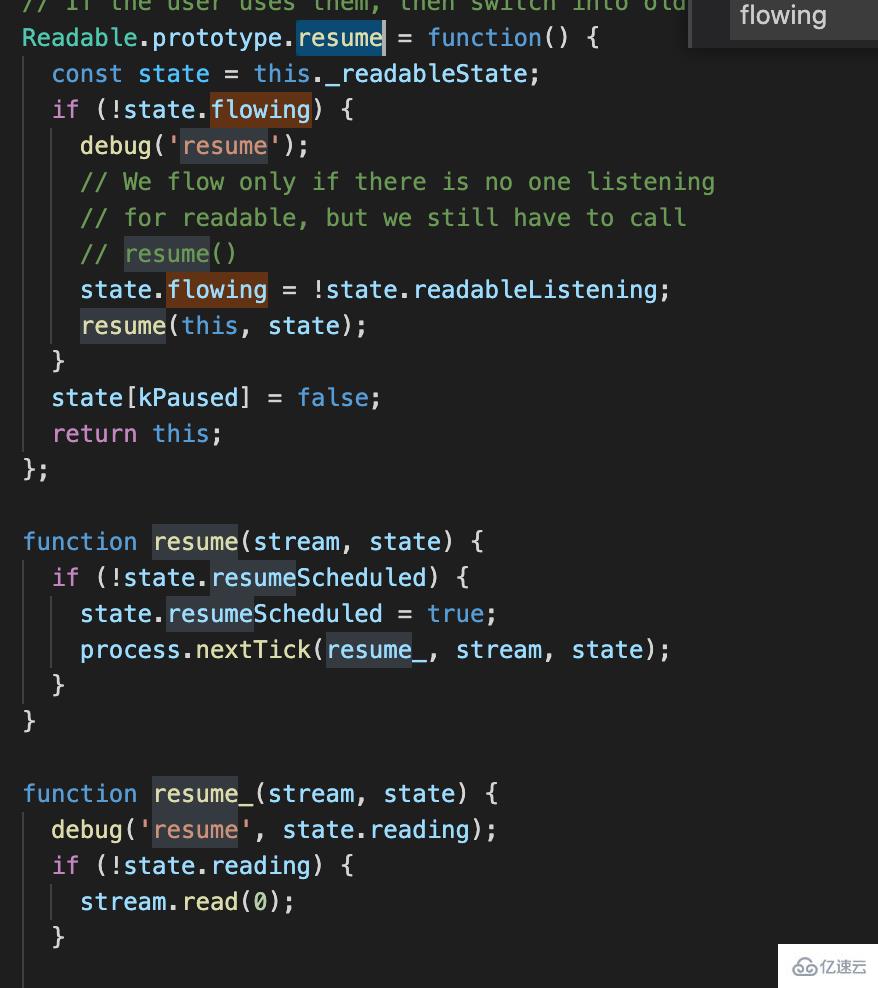您好,登錄后才能下訂單哦!
您好,登錄后才能下訂單哦!
這篇文章主要介紹“Nodejs中的可讀流的作用和實現方法”,在日常操作中,相信很多人在Nodejs中的可讀流的作用和實現方法問題上存在疑惑,小編查閱了各式資料,整理出簡單好用的操作方法,希望對大家解答”Nodejs中的可讀流的作用和實現方法”的疑惑有所幫助!接下來,請跟著小編一起來學習吧!
流(stream)是 Node.js 中處理流式數據的抽象接口。 stream 模塊用于構建實現了流接口的對象。【推薦學習:《nodejs 教程》】
讀寫大文件的過程中,不會一次性的讀寫到內存中。可以控制每次讀寫的個數
1、可讀流-Readable
例:fs.createReadStream;
源碼位置:lib/_stream_readable.js
2、可寫流-Writable
例:fs.createWriteStream;
源碼位置:lib/_stream_writable.js
3、雙工流-Duplex:滿足讀寫的功能
例:net.Socket();
源碼位置:lib/_stream_duplex.js
4、轉化流-Transform:用途:壓縮,轉碼
例:
const { Transform } = require('stream');
Transform.call(this, '要轉換的數據');//具體的使用詳情 見node官網-源碼位置:lib/_stream_tranform.js
讀取文件代碼過程
const path = require("path");
const aPath = path.join(__dirname, "a.txt");//需要讀取的文件
const fs = require("fs");
let rs = fs.createReadStream(aPath, {
flags: "r",
encoding: null,//默認編碼格式是buffer,深挖buffer又要學習字符編碼,留個坑 到時候寫一個編碼規范的學習整理
autoClose: true,//相當于需要調用close方法,如果為false 文件讀取end的時候 就不會執行 close
start: 0,
highWaterMark: 3,//每次讀取的個數 默認是64*1024個字節
});
rs.on("open", function (fd) {
// fd number類型
console.log("fd", fd);
});
// 他會監聽用戶,綁定了data事件,就會觸發對應的回調,不停的觸發
rs.on("data", function (chunk) {
//這里會打印的是ascII 值 ,所以可以toString查看詳情自己看得懂的樣子
console.log({ chunk }, "chunk.toString", chunk.toString());
//如果想每一段事件 讀一點 可以用rs.pause() 做暫停,然后計時器 里rs.resume()再次觸發data事件
rs.pause();//暫停讀取
});
rs.on("close", function () {
//當文件讀取完畢后 會 觸發 end事件
console.log("close");
});
setInterval(() => {
rs.resume(); //再次觸發data,直到讀完數據為止
}, 1000);題外話:想說下 文件流和普通可讀流的區別
1、open 和close是文件流獨有,支持open和close便是文件流
2、可讀流都具備 (on('data'),on('end'),on('error'),resume,pause;所以只要支持這些方法就是可讀流
寫入文件代碼過程
const fs = require("fs");
const path = require("path");
const bPath = path.join(__dirname, "b.txt");
let ws = fs.createWriteStream(bPath, {
//參數和可讀流的類似
flags: "w",
encoding: "utf-8",
autoClose: true,
start: 0,
highWaterMark: 3,
});
ws.on("open", function (fd) {
console.log("open", fd);
});
ws.on("close", function () {
console.log("close");
});
//write的參數string 或者buffer,ws.write 還有一個boolea的返回值表示是真實寫入文件還是放入緩存中
ws.write("1");
let flag = ws.write("1");
console.log({ flag });//true
flag = ws.write("1");
console.log({ flag });//true
flag = ws.write("1");
console.log({ flag });//false寫一個本地服務 做例子
1、server(服務器代碼)實現
const net = require("net"); //net 模塊是 node自己封裝的tcp層
//socket 就是雙工流 能讀能寫 http源碼就是用net模塊寫的 基于tcp
const server = net.createServer(function (socket) {
socket.on("data", function (data) {//監聽客戶端發來的消息
console.log(data.toString)
socket.write("server:hello");//寫入server:hello
});
socket.on("end", function () {
console.log("客戶端關閉");
});
});
server.on("err", function (err) {
console.log(err);
});
server.listen(8080);//服務端監聽8080端口2、client(客戶端) 實現
const net = require("net"); //net 模塊是 node自己封裝的tcp層
const socket = new net.Socket(); //
socket.connect(8080, "localhost"); // 表示鏈接服務器本地8080端口
socket.on("connect", function (data) {
//和服務器建立鏈接后
socket.write("connect server");
});
socket.on("data", function (data) {
//監聽數據,讀取服務器傳來的數據
console.log(data.toString());
socket.destroy()
});
socket.write('ok')
socket.on("error", function (err) {
console.log(err);
});3.題外話 如果想看tcp的三次握手和四次揮手 可以 通過我上述代碼 用wireshark(一個抓包工具)看實際過程
轉化流是雙工流的一種, 允許實現輸入,并在對數據執行某些操作后返回輸出,兩者有依賴關系
代碼過程(這個例子我的參考來處)
const stream = require('stream')
let c = 0;
const readable = stream.Readable({
highWaterMark: 2,
read: function () {
let data = c < 26 ? Number(c++ + 97) : null;
console.log('push', data);
this.push( String.fromCharCode(data));
}
})
const transform = stream.Transform({
highWaterMark: 2,
transform: function (buf, enc, next) {
console.log('transform', buf.toString());
next(null, buf);
}
})
readable.pipe(transform);打印結果

跟著斷點先了解 可讀流的調用過程
就前面可讀流文件的讀取過程的代碼為例子 打斷點
rs.on('open')rs.on('open')為斷點入口進入

1、通過Stream.prototype.on.call 繼承Stream類
源文件位置:no dlib/_stream_readable.js(我是通過斷點點到這里 直接找,我也沒找到)

再點進去 發現 Stream 是EventEmitter的子類 那么 可讀流也可以支持發布訂閱

2、監聽的事件類型是否是data和readable任意一個 不是 繼續 下一個事件的監聽

rs.on('data')
data的部分做兩件事
1、判斷flowing(默認值是null)不為false 就自動resume方法執行繼續 文件讀取(這里我的案例是rs.pause();手動將flowing 值為false了所以不會繼續調用)
2、那如果我沒有調用rs.pause() 會繼續調用resume 看看resume里做了什么

2.1 最終調用了 stream.read()繼續讀取文件;直到文件讀取結束依次去emit end 和close事件
小結:所以data默認是會不斷的讀取文件直到文件讀取完畢 ,如果想要文件讀取變可控可以和我一樣用rs.pause()
自己實現
實現思路
const fs = require("fs");
const EventEmitter = require("events");
class ReadStream extends EventEmitter {
}
module.exports = ReadStream;constructor(path, options = {}) {
super();
//參考fs 寫實例需要用到的參數
this.path = path;
this.flags = options.flags || "r";
this.encoding - options.encoding || null;//默認編碼格式是buffer
this.autoClose = options.autoClose || true;//相當于需要調用close方法,如果為false 文件讀取end的時候 就不會執行 close
this.start = options.start || 0;//數據讀取的開始位置
this.end = options.end;
this.highWaterMark = options.highWaterMark || 64 * 1024;//默認一次讀取64個字節的數據
this.offset = this.start;//fs.read的偏移量
this.fd = undefined; //初始化fd 用于 open成功后的fd做賦值 供 read里使用
this.flowing = false;//實現pause和resume備用,設置flag,當監聽到data事件的時候 改 flowing為true,
this.open(); //初始化的時候就要調用open
this.on("readStreamListener", function (type) {
// console.log(type)//這里打印就能看到 實例上所有 通過on 綁定的事件名稱
if (type === "data") {
//監聽到data事件的時候 改 flowing為true
this.flowing = true;
this.read();
}
});
} open() {
// 調用fs.open 讀取目標文件
fs.open(this.path, this.flags, (err, fd) => {
this.fd = fd; //賦值一個fd 供后面的 read()方式使用,文件讀取成功,fd是返回一個數字
this.emit("open", fd);
}); read() {
// console.log("一開始read里的", this.fd); //但是這樣依舊拿不到 open后的fd,用 發布訂閱 通過on來獲取 綁定的事件type
//這里要做一個容錯處理 ,因為open是異步讀取文件,read里無法馬上拿到open結果
if (typeof this.fd !== "number") {
//訂閱open,給綁定一個回調事件read 直到this.fd有值
return this.once("open", () => this.read());
}
}
//fd打開后 調用fs.read
//實例上的start值是未知number,存在實際剩余的可讀的文件大小<highWaterMar的情況 ,用howMuchToRead 替換highWaterMark 去做fs.read的每次讀取buffer的大小
let howMuchToRead = this.end
? Math.min(this.end - this.offset + 1, this.highWaterMark)
: this.highWaterMark;
//定義一個用戶 傳進來的highWaterMark 大小的buffer對象
const buffer = Buffer.alloc(this.highWaterMark);
//讀取文件中的內容fd給buffer 從0位置開始,每次讀取howMuchToRead個。插入數據,同時更新偏移量
fs.read(
this.fd,
buffer,
0,
howMuchToRead,
this.offset,
(err, bytesRead) => {
if (bytesRead) {
// 每讀完一次,偏移量=已經讀到的數量
this.offset += bytesRead;
this.emit("data", buffer.slice(0, bytesRead));
//寫到這里實例上的data 已經可以打印出數據了 但是 繼續讀取 調用this.read() 直到bytesRead不存在 說明數據讀取完畢了 走else
//回調 this.read();時候判斷 this.flowing 是否為true
//pause調用后this.flowing將為false
if (this.flowing) {
this.read();
}
} else {
// 執行到這 bytesRead不存在說明 文件數據讀取完畢了已經 觸發end
this.emit("end");//emit 實例上綁定的end事件
//destroy 還沒寫到 稍等 馬上后面就實現...
this.destroy();
}
}
);文件讀取不去data事件,會觸發對應的回調,不停的觸發 所以想要變可控可以手動調用 resume()& pause()
pause的實現,調用的時候設置 this.flowing=false,打斷 read()
pause() {
this.flowing = false;
}pause 打斷 read()多次讀取,可以使用resume 打開 this.flowing=true 并調用read
resume() {
if (!this.flowing) {
this.flowing = true;
this.read();
}
}文件open不成功時候拋錯時調用
文件讀取完畢后&&this.autoClose===true ,read()里文件讀取end的時候 就執行close
destroy(err) {
if (err) {
this.emit("error");
}
// 把close放destroy里 并 在read里調用
if (this.autoClose) {
fs.close(this.fd, () => {
this.emit("close");
});
}
}實現代碼
/**
*實現簡單的可讀流
*/
const fs = require("fs");
const EventEmitter = require("events");
class ReadStream extends EventEmitter {
constructor(path, options = {}) {
super();
//參考fs 寫實例需要用到的參數
this.path = path;
this.flags = options.flags || "r";
this.encoding - options.encoding || null;
this.autoClose = options.autoClose || true;
this.start = options.start || 0;
this.end = options.end;
this.highWaterMark = options.highWaterMark || 64 * 1024;
this.fd = undefined;
this.offset = this.start;
this.flowing = false;
this.open();
this.on("newListener", function (type) {
if (type === "data") {
this.flowing = true;
this.read();
}
});
}
destroy(err) {
if (err) {
this.emit("error");
}
if (this.autoClose) {
fs.close(this.fd, () => {
this.emit("close");
});
}
}
open() {
fs.open(this.path, this.flags, (err, fd) => {
if (err) {
return this.destroy(err);
}
this.fd = fd;
this.emit("open", fd);
});
}
resume() {
if (!this.flowing) {
this.flowing = true;
this.read();
}
}
pause() {
this.flowing = false;
}
read() {
if (typeof this.fd !== "number") {
return this.once("open", () => this.read());
}
let howMuchToRead = this.end
? Math.min(this.end - this.offset + 1, this.highWaterMark)
: this.highWaterMark;
const buffer = Buffer.alloc(this.highWaterMark);
fs.read(
this.fd,
buffer,
0,
howMuchToRead,
this.offset,
(err, bytesRead) => {
if (bytesRead) {
this.offset += bytesRead;
this.emit("data", buffer.slice(0, bytesRead));
if (this.flowing) {
this.read();
}
} else {
this.emit("end");
this.destroy();
}
}
);
}
}
module.exports = ReadStream;調用代碼
const ReadStream = require("./initReadStream");
let rs = new ReadStream(aPath, {
flags: "r",
encoding: null, //默認編碼格式是buffer
autoClose: true, //相當于需要調用close方法,如果為false 文件讀取end的時候 就不會執行 close
start: 0,
highWaterMark: 3, //每次讀取的個數 默認是64*1024個字節
});到此,關于“Nodejs中的可讀流的作用和實現方法”的學習就結束了,希望能夠解決大家的疑惑。理論與實踐的搭配能更好的幫助大家學習,快去試試吧!若想繼續學習更多相關知識,請繼續關注億速云網站,小編會繼續努力為大家帶來更多實用的文章!
免責聲明:本站發布的內容(圖片、視頻和文字)以原創、轉載和分享為主,文章觀點不代表本網站立場,如果涉及侵權請聯系站長郵箱:is@yisu.com進行舉報,并提供相關證據,一經查實,將立刻刪除涉嫌侵權內容。